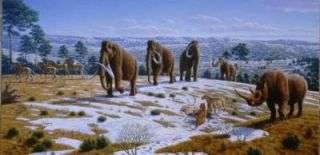Climate change, human hunting combine to drive the woolly mammoth extinct

Does the human species have mammoth blood on its hands" Scientists have long debated the relative importance of hunting by our ancestors and change in global climate in consigning the mammoth to the history books. A new paper, published in this week’s open-access journal PLoS Biology, uses climate models and fossil distribution to establish that the woolly mammoth went extinct primarily because of loss of habitat due to changes in temperature, while human hunting acted as the final straw.
It has been particularly difficult to untangle these two potential causes of extinction, as climate change and increased human hunting are linked. When the climate in mammoth territory started to become too warm for the furry beast, it allowed humans—who couldn’t handle the lower, mammoth-friendly temperatures—to move into the area.
Therefore, the mammoth faced the heat and predation pressure from hunting in the same regions at approximately the same times, making it difficult to test the importance of the two factors independently. It had also been argued that, as the mammoth had survived many temperature fluctuations previous to those that coincided with its demise, it was only human hunting that was a substantially different condition that could have caused the extinction of the species.
Work by David Nogues-Bravo and colleagues has ended the debate, by using mathematical modelling to separate the two factors. They predicted climate and species distribution at different times in mammoth history—126,000, 42,000, 30,000, 21,000, and 6,000 years ago—considering temperature and rainfall simulations alongside the age and locations of fossils. The results show that the mammoth suffered a catastrophic loss of habitat, with the species 6,000 years ago relegated to 10% of the habitat available to it 42,000 years ago (when the glaciers were at their biggest).
In fact, things were much worse for the mammoth 126,000 years ago when globally high temperatures restricted its habitat even more than at 6,000 years ago. At both of these times, the climate-related habitat loss would have forced the species to the brink of extinction. The nail in the mammoth’s coffin 6,000 years ago was that, during the later extinction crisis, the mammoth also faced evolutionarily modern humans. Nogues-Bravo et al. estimate that, for an optimistic estimate of mammoth numbers 6000 years ago, humans would only have had to kill one mammoth each every three years to push the species to extinction. If they are pessimistic about mammoth-climate survival, that figure reaches one mammoth per human every 200 years.
Thus, it seems that, in the case of the mammoth, it was the climate that forced the species to the point of extinction, and it was mankind that gave the woolly beast the last shove into oblivion.
Citation: Nogués-Bravo D, Rodríguez J, Hortal J, Batra P, Araújo MB (2008) Climate change, humans, and the extinction of the woolly mammoth. PLoS Biol 6(4): e79. doi:10. 1371/journal.pbio.0060079 (www.plosbiology.org)
Source: Public Library of Science















